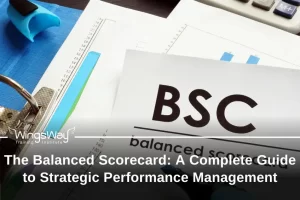Lean Six Sigma Course Overview
Lean Six Sigma (LSS) combines Kaizen methodologies with Six Sigma methodologies to optimise efficiency and reduce waste while maintaining quality. It’s ideal for professionals in industries that aim to enhance efficiency and customer value.
LSS certifications are also structured into a hierarchy of five belts—White, Yellow, Green, and Black—each signifying a specific level of expertise and responsibility. This structured system ensures that learners advance systematically, gaining deeper knowledge and skills as they progress.
Lean Six Sigma certifications equip learners with tools to identify wasteful practices, streamline processes, and achieve sustainable and quality improvements. Benefits include increased productivity, reduced costs, and improved customer satisfaction.
Download Brochure
Recognitions
WingsWay Training Institute, a globally recognised and trusted Authorised Training Centre, ensures you receive top-quality education and recognition for your efforts. Our commitment to delivering exceptional private education in Dubai has earned us the endorsement of the Knowledge and Human Development Authority (KHDA) and ISO 9001:2015 certification from the International Accreditation Forum (IAF).
Furthermore, WingsWay Training Institute proudly received the title of ‘Best Training Institute’ twice and the ‘Outstanding Organisation Award’. Our services and training quality have not only been recognised by students in over 80 countries but also by top international organisations.
Course Duration
Green Belt – 20 hours
Black Belt 30 hours
Combo – 32 hours
Learners Profile
Executives in any industries
Project Managers
Quality Analysts and Managers
Supervisors
Front-Line employees
Quality and Process Improvement Teams
Entrepreneurs and leaders
Auditors
Engineers
Course Language
- English
Entry Qualifications
- No prior knowledge of Lean Six Sigma is required for the Yellow Belt.
- For Black Belt, completion of Green Belt certification is typically expected along with project experience.
Career Opportunities
After completing Lean Six Sigma certification, learners can pursue roles such as:
- Process Improvement Specialist
- Quality Assurance Analyst
- Project Manager
- Operations Manager
- Business Analyst
- Lean Consultant
- Continuous Improvement Manager
- Six Sigma Analyst
- Manufacturing Engineer
- Quality Engineer
- Operational Excellence Leader
Course Outline
LSS Yellow Belt Certification
Unit 1 – Define Phase
- The basics of Six Sigma
- The fundamentals of Six Sigma
- Selecting Lean Six Sigma projects
- The Lean enterprise
Unit 2 – Measure Phase
- What is Process?
- Six Sigma statistics
- Measurement System Analysis
- Process capability
Unit 3 – Control Phase
- Lean controls
- Six Sigma control plans
LSS Green Belt Certification
Unit 1 – Introduction to Lean and Six Sigma
- Introduction to quality
- Introduction to Lean
- Introduction to Six Sigma
- Evolution of Lean Six Sigma as an integrated approach
- Overview of the DMAIC methodology
- Roles and responsibilities in an LLS project
Unit 2 – Define Phase
- The basics of Six Sigma
- The fundamentals of Six Sigma
- Selecting Lean Six Sigma projects
- The Lean enterprise
Unit 3 – Measure Phase
- Process definition
- Six Sigma statistics
- Measurement System Analysis
- Process capability
Unit 4 – Control Phase
- Lean controls
- Six Sigma control plans
Unit 5 – Improve Phase
- Develop potential solutions
- Design go-to process
- Kaizen
- Kanban
- 5S
- Poka Yoke
- Cellular Design
- Validate potential solutions with pilot
- Update policies, process flows, and procedures.
Unit 6 – Analyse Phase
- Establish cause-effect relationship
- Process analysis & data analysis
- Key focus areas in process analysis
- Identify potential root cause(s)
- Validate potential root causes
LSS Black Belt Certification
Unit 1 – Introduction to Statistics and Estimation
- Introduction to statistics
- Normal distribution
- Introduction to Six Sigma
- Control limits and specification limits
- Probabilities of defects
- Estimation
Unit 2 – Data Visualisation Tools
- Normal probability plot
- Visualising data with single variable
- Visualising data with two variables
Unit 3 – Hypothesis Testing
- Root cause validation using statistical thinking
- Hypothesis testing
- Understanding null/alternate hypothesis & p-value
- Overview of design of experiments
Unit 4 – Control Charts
- Introduction to statistical process control
- Common cause versus special cause
- Control charts
- Rational sub-grouping
Bring this Course In-House!
Upskill & Drive Results



